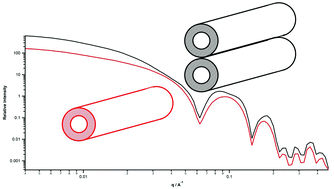Building blocks of β-sitosterol-γ-oryzanol gels revealed by small-angle neutron scattering and real space modelling†
Abstract
Mixtures of β-sitosterol and γ-oryzanol form gels in a range of organic solvents. Despite being widely studied, particularly as potential oleogels for food application, details of the intrinsic gel-forming building blocks remain unclear. Small-angle neutron scattering (SANS) combined with solvent contrast variation has been used to evaluate potential structural models. While evidence exists that the building blocks are hollow cylinders (tubules), the simultaneous fitting of twelve contrast-varied SANS data sets indicates that the previously proposed model of double walled tubules is incorrect. Predicted scattering based on real space models provides compelling evidence that the origin of the gelling behaviour is the limited assembly of adjacent tubules to form a space-filling network of fibrils.



 Please wait while we load your content...
Please wait while we load your content...